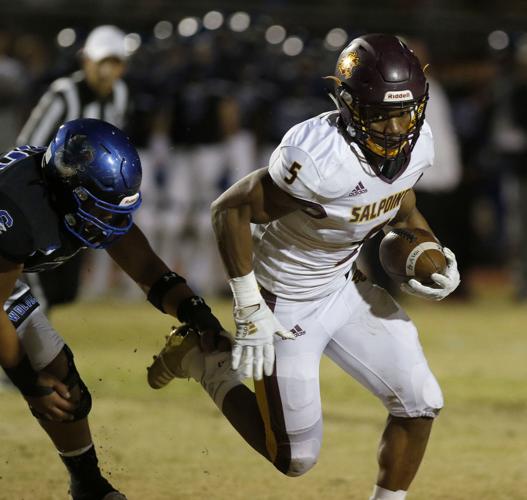The UA athletic council voted to accept a bid to the 1941 Sun Bowl and then asked coach Miles Casteel to conduct a vote of the 7-3 Wildcat football team. In what now seems astonishing, the Wildcats voted 41-2 not to play in the El Paso bowl.
Casteel told reporters that the players wanted to be able to get home for Christmas.
Over the next 37 years, Arizona was invited to just two bowl games, the 1948 Salad Bowl in Phoenix and the 1968 Sun Bowl in El Paso. Being home for Christmas became a sign of football failure.
Arizona no longer holds a vote. Even when the Wildcats played in the low-brow Independence Bowl in icy Shreveport, Louisiana, on New Year’s Eve (2013) and in Tucson’s inaugural Copper Bowl (1989), being part of the bowl gang was a stamp of success.
Now? No stamp.
The Wildcats didn’t qualify for a bowl game for the third time in four seasons, which isn’t easy. There are 39 bowl games this season, meaning 78 of the 131 FBS teams — 60 percent — are engaged in preparations for such things as the Redbox Bowl and the LendingTree Bowl.
UA coaches will be able to spend more time on recruiting, which is far more important than playing in the Cheez-It Bowl. How did Arizona get in this unwelcome, no-bowl-for-the-holidays spot?
Ineffective recruiting.
It always comes back to recruiting.
The No. 1 reason Arizona has the worst record in Pac-12 football this century is because it recruited poorly. With a second decade of 21st century conference games now in the books, here’s how it stands at the bottom:
Arizona 66-108
Cal 72-102
WSU 72-102
Oregon State 78-96
What makes it more head-shaking for UA fans is that in the previous two decades, the ’80s and ’90s, Arizona went 87-65-6 in conference games.
That’s a bottom-line collapse like few in college sports. The Wildcats lost 43 more games in the last 20 seasons.
Their lack of success against Top 25 teams — a measuring stick of national relevance — is push-the-alarm stuff.
In the ‘80s and ‘90s, Arizona went 26-38-1 against Top 25 opponents.
In the 21st century, Arizona has gone 19-60 against the Top 25.
You don’t have to look beyond Tucson to find one of the key variables to Arizona’s lack of recruiting success.
In the 1990s, high schools in the greater Tucson area produced 41 FBS scholarship players. Arizona signed 27 of them.
From 2000-09, that number plummeted to 11; Arizona signed nine.
In the last 10 recruiting classes, 2010-19, the numbers grew only slightly: Arizona signed 12 players from Tucson. Two, CDO’s Blake Martinez and Washington’s Matteo Mele, went to rival Pac-12 schools.
Without the trigger of a local recruiting base that flourished in the ‘90s, Arizona has struggled. That’s why it was so damaging when Salpointe Catholic prospects Bijan Robinson, Lathan Ransom and Bruno Fina chose not to play for the Wildcats.
Imagine how Dick Tomey’s career might have gone had not the period from 1988-99 produced 30 Wildcats from hometown schools, starting with future NFL players Amphi’s Michael Bates and Salpointe’s John Fina. Those local players were a significant part of putting Arizona in the AP Top 25 during 67 weeks of that period.
In this decade, Arizona was a Top 25 team in just 26 weeks.
The Arizona recruiting Class of 1990 set the stage for the entire decade and Tomey took full advantage. The ‘90 Class included seven Tuconans, among them future first-team All-American place-kicker Steve McLaughlin of Sahuaro; third-team All-American linebacker Sean Harris of Tucson High; future NFL defensive back Mike Scurlock of Pueblo; Parade All-American lineman Mike Ciasca of Sahuaro and valued starting offensive lineman Mike Heemsbergen of Santa Rita.
Prep football in Tucson was so rich in high-level prospects in the ‘90s that the big-names Arizona lost — Jon McGee, Junior Rickman, Doyal Butler and Greg Tellam to USC; Mario Bates to ASU; Brian Poli-Dixon and Mike Saffer to UCLA; Corey HIll to Stanford; Brady Doe to Purdue; David Andrews to Colorado — didn’t create a negative backlash the way this year’s Salpointe players did.
UA coaches were able to mix Tucson players into future All-Pac-10 players such as Tedy Bruschi, Chuck Osborne, Tony Bouie, Marcus Bell and Trung Canidate.
In the ‘80s and ‘90s, Arizona had 61 All-Pac-10 first-team selections. This decade: six.
You can’t win in Pac-12 football unless you have star-level players.
Nor can you expect to win at this level when you don’t find and develop hometown players.
Of the 21 local scholarship players to enroll at Arizona from 2000-19, the majority did not develop into useful players. Tremaine Cox, Xavier Smith, Glyndon Bolasky, Brandon Lopez, Justin Holt, Kaelin Deboskie, Cam Denson, Jacob Arzouman, Josh Robbins, Daniel Borg, Adam Hall and Rhett Rodriguez either saw limited playing time or left school. Young linemen David Watson and Jordan Morgan are still in the growth process.
In the last 20 years, only Ka’Deem Carey and Brooks Reed played at an all-conference level.
Without bowl game preparations, the UA coaching staff has spent the last 10 days recruiting out of town.
The early signing date is next week. How’s it going? According to Rivals.com, Arizona’s Class of 2020 was ranked No. 61 overall through Sunday.
That trails No. 26 Cal, No. 29 Colorado, No. 33 ASU, No. 49 Washington State and No. 57 Oregon State, all teams that Arizona needs to beat to again become relevant — all teams that are busy preparing for bowl games.
Sometimes, being home for Christmas isn’t all it’s cracked up to be.





